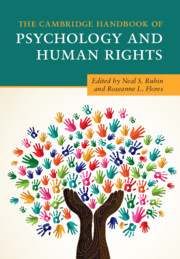Book contents
- The Cambridge Handbook of Psychology and Human Rights
- The Cambridge Handbook of Psychology and Human Rights
- Copyright page
- Dedication
- Contents
- Figures
- Tables
- Boxes
- Contributors
- Acknowledgments
- The Core International Human Rights Instruments and Their Monitoring Bodies
- Universal Human Rights Instruments
- Sustainable Development Goals
- Glossary of United Nations and Psychology Acronyms in the Handbook
- Introduction
- Part I History of Human Rights
- Part II The Intersection of Psychology and Human Rights
- 5 The Intersection of Psychology and Human Rights in Addressing Racism, Discrimination, and Xenophobia
- 6 Poverty and the Human Rights of Children and Youth through the Lenses of Psychology and Sociology
- 7 Labor Rights as Human Rights
- 8 Whose Culture? Challenging the Idea of an Opposition between Women’s Human Rights and the Right to Culture
- 9 Human Rights
- 10 Child Rights
- 11 Human Rights of Persons with Disabilities
- Part III Contemporary Issues in Psychology and Human Rights
- Part IV Teaching, Research, and Training in Psychology and Human Rights
- Part V Future Directions
- Index
- References
6 - Poverty and the Human Rights of Children and Youth through the Lenses of Psychology and Sociology
from Part II - The Intersection of Psychology and Human Rights
Published online by Cambridge University Press: 02 October 2020
- The Cambridge Handbook of Psychology and Human Rights
- The Cambridge Handbook of Psychology and Human Rights
- Copyright page
- Dedication
- Contents
- Figures
- Tables
- Boxes
- Contributors
- Acknowledgments
- The Core International Human Rights Instruments and Their Monitoring Bodies
- Universal Human Rights Instruments
- Sustainable Development Goals
- Glossary of United Nations and Psychology Acronyms in the Handbook
- Introduction
- Part I History of Human Rights
- Part II The Intersection of Psychology and Human Rights
- 5 The Intersection of Psychology and Human Rights in Addressing Racism, Discrimination, and Xenophobia
- 6 Poverty and the Human Rights of Children and Youth through the Lenses of Psychology and Sociology
- 7 Labor Rights as Human Rights
- 8 Whose Culture? Challenging the Idea of an Opposition between Women’s Human Rights and the Right to Culture
- 9 Human Rights
- 10 Child Rights
- 11 Human Rights of Persons with Disabilities
- Part III Contemporary Issues in Psychology and Human Rights
- Part IV Teaching, Research, and Training in Psychology and Human Rights
- Part V Future Directions
- Index
- References
Summary
This chapter attempts a dialogue between developmental psychology and sociology to explore the potential contribution a joint approach can make to understanding children’s human rights, with a focus on addressing childhood poverty. We reflect upon the relevance of our respective disciplines for thinking about children’s human rights and explore some of the tensions as well as complementarities between psychology and sociology. Beginning with a brief history of children’s rights, we explain the basics of the UN Convention on the Rights of the Child and introduce the theoretical framework of “living rights, social justice and translations.” Second, we address what our differing disciplines offer to the study and advancement of children’s rights, starting with psychology before outlining a sociological approach and how perspectives from both disciplines enrich an understanding of living rights. Our third section takes childhood poverty as an example to explore rights questions – defining child poverty as multidimensional and drawing on research from our respective fields. Fourth, we link children’s rights and poverty by focusing on a topic of vital importance to children’s well-being, that of violence. We conclude by summarizing the contributions that developmental psychology and sociology can make to understanding and translating children’s rights.
- Type
- Chapter
- Information
- The Cambridge Handbook of Psychology and Human Rights , pp. 90 - 104Publisher: Cambridge University PressPrint publication year: 2020
References
- 2
- Cited by



